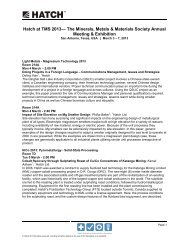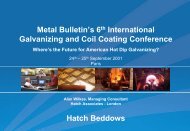Download PDF - Hatch
Download PDF - Hatch
Download PDF - Hatch
Create successful ePaper yourself
Turn your PDF publications into a flip-book with our unique Google optimized e-Paper software.
underflow slurry is pushed to<br />
a carbon-in-leach circuit. Also<br />
in the autoclaves, the carbon<br />
contained in the sedimentary<br />
materials is oxidized with the<br />
combination of oxygen and high<br />
temperatures.<br />
Within the autoclaves, oxygen<br />
is the primary reagent. During<br />
design of the autoclaves, <strong>Hatch</strong><br />
included a heat recovery circuit<br />
that, combined with the nature<br />
of the exothermic reactions<br />
that produce heat within the<br />
autoclaves, makes the heat<br />
autogenous by design. “Without<br />
the heat recovery system, we<br />
would need some external<br />
heat source,” Fraser adds.<br />
“This way, we keep the energy<br />
needs down.” The Pueblo<br />
Viejo autoclaves are the largest,<br />
by weight, refractory-lined<br />
autoclaves built to date globally,<br />
with an onhook weight of 780<br />
tonnes when shipped lead lined.<br />
The massive structures are each<br />
5.6 metres by 34.8 metres, and<br />
will nominally operate at 230<br />
degrees Celsius. There are four<br />
in total.<br />
The grand voyage<br />
<strong>Hatch</strong> designed the autoclaves<br />
and provided quality assurance<br />
during fabrication. They were<br />
built by KNM Process Systems<br />
Sdn Bhd in Gebeng, Malaysia.<br />
“We had two full-time quality<br />
assurance inspectors on site<br />
throughout the 33-month<br />
fabrication,” Fraser recalls.<br />
The autoclaves were then<br />
shipped approximately<br />
10 kilometres to the Kuantan<br />
Port using a 24-line, selfpropelled<br />
modular transporter<br />
(SPMT) heavy-haul unit. At the<br />
port, they were loaded on the<br />
Beluga Bremen, a P2-class ship<br />
owned by Beluga Charters out of<br />
Germany, for its maiden voyage.<br />
The autoclaves were transported<br />
in two shipments of two<br />
autoclaves each on the Bremen,<br />
which used both of its 750-tonne<br />
cranes and needed six hours<br />
to load the autoclaves from the<br />
SPMT into the cargo hold.<br />
“We had two full-time<br />
quality assurance<br />
inspectors on site<br />
throughout the<br />
33-month fabrication”<br />
The ocean voyage took four<br />
weeks one way, heading<br />
through the Panama Canal to<br />
reach Samana in northeastern<br />
Dominican Republic. “Samana<br />
is basically an old and unused<br />
former cruise ship pier that<br />
was refurbished for the Pueblo<br />
Viejo project, including the<br />
autoclaves,” Fraser explains.<br />
There, the autoclaves were<br />
transferred from the Bremen<br />
onto a 4.9-metre-wide 22-line<br />
Goldhofer heavy-haul trailer unit<br />
to transport the autoclaves over<br />
120 kilometres to the Pueblo<br />
Viejo site, a trek that took about<br />
18 days, and had to be repeated<br />
for each of the four autoclaves.<br />
“I think I’ve walked every<br />
kilometre of that route – I’ve<br />
definitely driven it many times,”<br />
says Fraser. “The Goldhofer<br />
moves at an average of two<br />
kilometres per hour and can only<br />
operate during the daytime.”<br />
Prior to the autoclaves arriving<br />
in the Dominican Republic, the<br />
project of readying the route to<br />
get them to site took about<br />
16 months. Due to the sheer<br />
size of the autoclaves, there<br />
were a lot of interference issues<br />
to deal with: trees, power lines,<br />
communications lines, signs in<br />
villages that had been modified<br />
so they could rotate, and bridges<br />
(some had been temporarily<br />
reinforced to support the excess<br />
weight of the load; others had<br />
metal ramp structures added<br />
along each side to allow the<br />
Goldhofer to drive over them).<br />
The actual trek across the land<br />
with the autoclaves required<br />
a number of teams. Heavy<br />
lifting and transport specialist<br />
Mammoet Caribbean Inc. was<br />
responsible for driving the<br />
Goldhofer. A crane and ramp<br />
team moved the ramps – the<br />
team would go ahead, ramp<br />
up a bridge, and then once the<br />
Goldhofer crossed, dismantle<br />
the ramp, move ahead of the<br />
Goldhofer and ramp up the next<br />
bridge. A safety team acted as<br />
an escort and ensured all were<br />
well-fed and hydrated, while<br />
also providing necessary crowd<br />
control near towns.<br />
Upon reaching the massive<br />
gates at Pueblo Viejo, which<br />
12


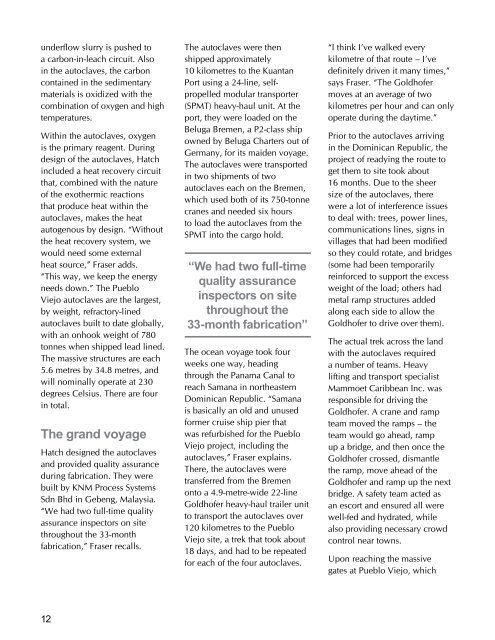
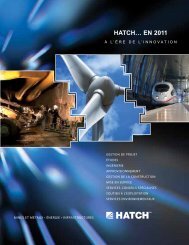
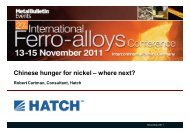
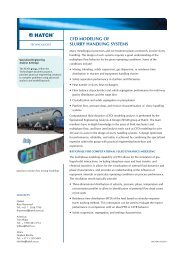




![Presentation: Global Overview of Line Pipe [pdf, 618 KB] - Hatch](https://img.yumpu.com/22183381/1/190x132/presentation-global-overview-of-line-pipe-pdf-618-kb-hatch.jpg?quality=85)
![Sustainable Development Report 2010 [pdf, 2.13 MB] - Hatch](https://img.yumpu.com/22183361/1/190x245/sustainable-development-report-2010-pdf-213-mb-hatch.jpg?quality=85)
![This is Hatch 2011 - Our Organization [pdf, 636 KB]](https://img.yumpu.com/22183357/1/190x245/this-is-hatch-2011-our-organization-pdf-636-kb.jpg?quality=85)
![Annual Review - This is Hatch 2006 [pdf, 1.88 MB]](https://img.yumpu.com/22183355/1/190x245/annual-review-this-is-hatch-2006-pdf-188-mb.jpg?quality=85)
![Hatch Safety Report 2007 [pdf, 2.89 MB]](https://img.yumpu.com/22183353/1/190x245/hatch-safety-report-2007-pdf-289-mb.jpg?quality=85)
![Structural Assets Newsletter #16, October 2002 [pdf, 322 KB] - Hatch](https://img.yumpu.com/22183350/1/184x260/structural-assets-newsletter-16-october-2002-pdf-322-kb-hatch.jpg?quality=85)
